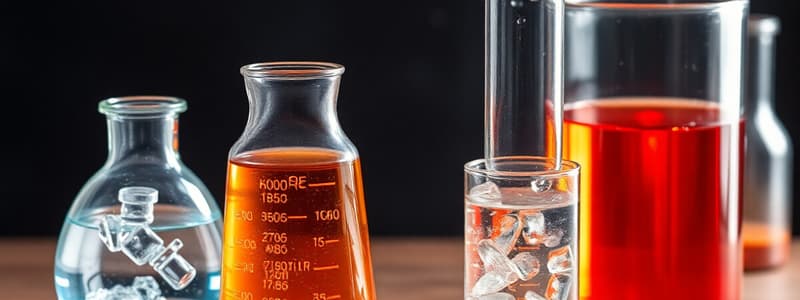Podcast
Questions and Answers
What is the minimum amount of energy needed for the colliding particles to react called?
What is the minimum amount of energy needed for the colliding particles to react called?
- Heat of Reaction
- Activation Energy (correct)
- Enthalpy
- Thermal Energy
Which of the following is NOT a factor that influences the rate of a reaction?
Which of the following is NOT a factor that influences the rate of a reaction?
- The concentration of the reactants
- The surface area of the reactants
- The temperature of the reactants
- The volume of the reactants (correct)
Which of the following statements is TRUE about endothermic reactions?
Which of the following statements is TRUE about endothermic reactions?
- They always feel hot to the touch.
- The products have a lower energy level than the reactants.
- They require energy input from the surroundings. (correct)
- They release energy into the surroundings.
Why is breaking chemical bonds an endothermic process?
Why is breaking chemical bonds an endothermic process?
Which of the following is true regarding the energy profile of an endothermic reaction?
Which of the following is true regarding the energy profile of an endothermic reaction?
What is the term used to describe the transfer of thermal energy in a chemical reaction?
What is the term used to describe the transfer of thermal energy in a chemical reaction?
What does a positive enthalpy change (∆H) indicate about a chemical reaction?
What does a positive enthalpy change (∆H) indicate about a chemical reaction?
In a chemical reaction, what does a positive change in enthalpy (∆H) indicate?
In a chemical reaction, what does a positive change in enthalpy (∆H) indicate?
Which of the following is NOT a factor that affects the rate of a chemical reaction?
Which of the following is NOT a factor that affects the rate of a chemical reaction?
A chemical reaction is considered to be fast if:
A chemical reaction is considered to be fast if:
What is the name of the minimum amount of energy required for a chemical reaction to occur?
What is the name of the minimum amount of energy required for a chemical reaction to occur?
How does increasing the surface area of a solid reactant affect the rate of reaction?
How does increasing the surface area of a solid reactant affect the rate of reaction?
What is the significance of the gradient of a graph plotting the concentration of a product against time in a chemical reaction?
What is the significance of the gradient of a graph plotting the concentration of a product against time in a chemical reaction?
Which of the following is a true statement about catalysts?
Which of the following is a true statement about catalysts?
In a chemical reaction, what does the term "effective collision" refer to?
In a chemical reaction, what does the term "effective collision" refer to?
Which of the following is NOT a characteristic of a physical change?
Which of the following is NOT a characteristic of a physical change?
Which of the following examples is NOT a chemical change?
Which of the following examples is NOT a chemical change?
Which of the following is an example of an endothermic reaction?
Which of the following is an example of an endothermic reaction?
Flashcards
Exothermic Reaction
Exothermic Reaction
A reaction that transfers thermal energy to the surroundings, increasing their temperature.
Endothermic Reaction
Endothermic Reaction
A reaction that takes in thermal energy from the surroundings, decreasing their temperature.
Activation Energy
Activation Energy
The minimum energy required for colliding particles to react.
Rate of Reaction
Rate of Reaction
Signup and view all the flashcards
Energy Profile
Energy Profile
Signup and view all the flashcards
Enthalpy Change (∆H)
Enthalpy Change (∆H)
Signup and view all the flashcards
Product Energy in Exothermic
Product Energy in Exothermic
Signup and view all the flashcards
Product Energy in Endothermic
Product Energy in Endothermic
Signup and view all the flashcards
Physical Change
Physical Change
Signup and view all the flashcards
Chemical Change
Chemical Change
Signup and view all the flashcards
Collision Theory
Collision Theory
Signup and view all the flashcards
Catalyst
Catalyst
Signup and view all the flashcards
Concentration Effect
Concentration Effect
Signup and view all the flashcards
Law of Conservation of Mass
Law of Conservation of Mass
Signup and view all the flashcards
Study Notes
Exothermic and Endothermic Reactions
- Exothermic reaction: Releases thermal energy to the surroundings, increasing their temperature. Heat is given out.
- Endothermic reaction: Absorbs thermal energy from the surroundings, decreasing their temperature. Heat is taken in.
- Distinguishing feature: Exothermic reactions "exit" energy from the system, endothermic reactions "enter" energy into the system.
- Chemical Reaction: Rearrangement of atoms in reactants to form products.
- Breaking bonds: Requires energy (endothermic), as energy is taken in to break chemical bonds.
- Forming bonds: Releases energy (exothermic). Energy is released to the surroundings as bonds form.
- Collision Theory: Reactions occur when particles collide with enough energy.
- System: The reacting chemicals.
- Surroundings: Everything outside the reacting chemicals.
- Activation Energy: Minimum energy needed for particles to react upon collision.
Rate of Reaction
- Factors affecting rate:
- Collision frequency: Increased collisions lead to faster reactions.
- Collision energy: Higher energy collisions are more likely to cause reactions.
- Temperature: Higher temperature → faster reaction (increased kinetic energy).
- Higher temperature increases collision frequency and energy → greater chance of effective collisions.
- Concentration: Higher concentration → faster reaction (more particles, more collisions).
- Pressure (gases): Higher pressure → faster reaction (more particles in same volume, more collisions).
- Surface area: Larger surface area → faster reaction (more surface exposed, more collisions).
- Catalysts: Increase reaction rate by lowering activation energy.
Energy Profiles
- Exothermic: Products have lower energy than reactants, energy is released. Downward arrow in energy profile. ΔH is negative.
- Endothermic: Products have higher energy than reactants, energy is absorbed. Upward arrow in energy profile. ΔH is positive.
- Enthalpy change (ΔH): Transfer of thermal energy during the reaction; ΔH is negative for exothermic reactions, and positive for endothermic reactions.
Chemical vs Physical Changes
- Physical change: No new substance is created. Same elements, different forms (e.g., melting). Mixtures can be separated.
- Chemical change: Requires a chemical reaction. New substances with different compositions are formed. Mass is conserved (total product mass = total reactant mass).
Rates of Reactions - Practical Methods
- Ways to track the rate of a reactions includes monitoring changes like mass of reactants used/time, product formed/time, gas volume produced/time, or other appropriate quantities.
Collision Theory
- Key points:
- Collisions are required for reactions.
- Collisions need sufficient energy and correct orientation for product formation (effective collisions).
Chemical Equations
- Reactants → Products: Symbols representing substances involved in a reaction.
- Law of Conservation of Mass: Mass of reactants equals mass of products.
Calculating Rates from Graphs
- Slope/Gradient: Reaction rate can be determined graphically from the slope of a graph plotting concentration versus time.
Studying That Suits You
Use AI to generate personalized quizzes and flashcards to suit your learning preferences.




